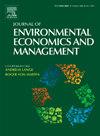Environmental health risks, welfare and GDP
IF 5.9
3区 经济学
Q1 BUSINESS
Journal of Environmental Economics and Management
Pub Date : 2025-07-05
DOI:10.1016/j.jeem.2025.103206
引用次数: 0
Abstract
A seemingly overlooked impact on economic well-being is rising health risks attributed to the environment, which are impacting welfare worldwide. We modify the consumption-equivalent macroeconomic welfare measure developed by Jones and Klenow (2016) to include the impacts of these risks on life expectancy and the utility flow of the average individual. Employing the Global Burden of Disease dataset of environmentally related mortality and morbidity across 163 countries over 1990–2019, we compare welfare with and without environmental health risks to GDP per capita for each country relative to the United States. In addition, we examine the extent to which welfare in rich and poor countries converge. Across all 163 countries over 1990–2019, adjusting welfare for environmental health risks is significant when compared to income (GDP) per capita or to welfare that excludes these risks. This divergence in welfare is especially prominent among low and lower middle-income countries.
环境健康风险、福利和国内生产总值
对经济福祉的一个似乎被忽视的影响是环境导致的健康风险上升,这正在影响全世界的福利。我们修改了Jones和Klenow(2016)开发的消费等效宏观经济福利指标,以包括这些风险对预期寿命和平均个人效用流的影响。利用1990年至2019年163个国家环境相关死亡率和发病率的全球疾病负担数据集,我们比较了每个国家与美国相比,有和没有环境健康风险的福利对人均GDP的影响。此外,我们还研究了富国和穷国福利趋同的程度。在1990年至2019年期间,与人均收入(GDP)或排除这些风险的福利相比,在所有163个国家中,根据环境健康风险调整福利具有重要意义。这种福利差异在低收入和中低收入国家尤为突出。
本文章由计算机程序翻译,如有差异,请以英文原文为准。
求助全文
约1分钟内获得全文
求助全文
来源期刊
CiteScore
8.00
自引率
4.30%
发文量
91
期刊介绍:
The Journal of Environmental Economics and Management publishes theoretical and empirical papers devoted to specific natural resources and environmental issues. For consideration, papers should (1) contain a substantial element embodying the linkage between economic systems and environmental and natural resources systems or (2) be of substantial importance in understanding the management and/or social control of the economy in its relations with the natural environment. Although the general orientation of the journal is toward economics, interdisciplinary papers by researchers in other fields of interest to resource and environmental economists will be welcomed.

 求助内容:
求助内容: 应助结果提醒方式:
应助结果提醒方式:


